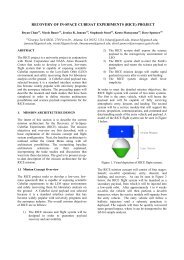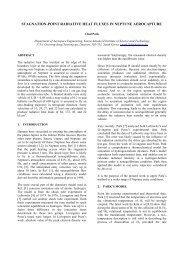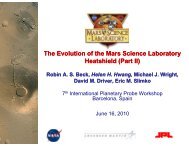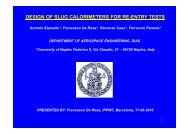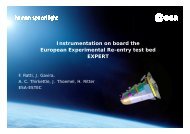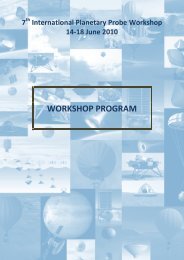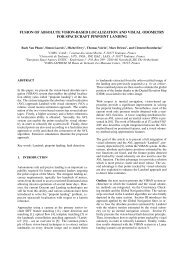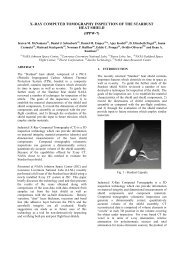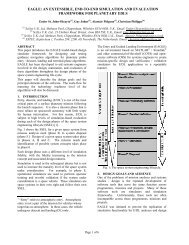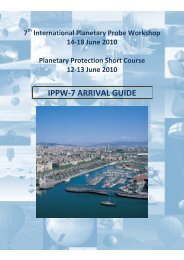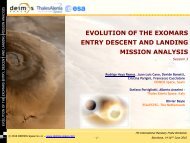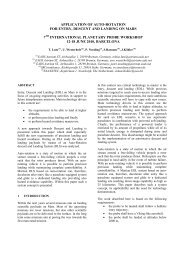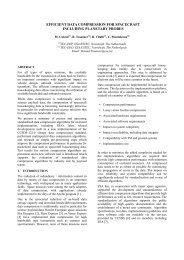Paper 342 - International Planetary Probe Workshop
Paper 342 - International Planetary Probe Workshop
Paper 342 - International Planetary Probe Workshop
You also want an ePaper? Increase the reach of your titles
YUMPU automatically turns print PDFs into web optimized ePapers that Google loves.
Saturn system tour phase<br />
24 months<br />
Number of close Enceladus encounters during the Saturn tour 7<br />
Number of Titan encounters during the Saturn tour 16<br />
Titan aerosampling phase<br />
2 months<br />
Titan orbital phase<br />
20 months<br />
Radiation design point*<br />
4.9 Tb<br />
>300 Gb – 1.3 Tb<br />
>500 Mb – 3.4 Gb<br />
3. TSSM FLIGHT SYSTEM OVERVIEW<br />
The TSSM baseline flight system would be composed<br />
of three elements—the orbiter, augmented by an SEP<br />
stage; a multi-mission radioisotope thermoelectric<br />
generator (MMRTG)-powered montgolfière; and a<br />
battery-powered lake lander.<br />
3.1 Titan Orbiter<br />
The TSSM orbiter (Fig. 8) concept is a three-axis<br />
stabilized spacecraft powered by radioisotope power<br />
systems (RPSs) that has strong similarity to the Cassini<br />
orbiter. The TSSM orbiter would include an articulated<br />
4 m high gain antenna (HGA) using Ka-band for highrate<br />
science data downlink. A planning payload of six<br />
instruments plus radio science is accommodated with<br />
the model instruments located on a payload deck, as<br />
well as other locations on the spacecraft dictated by<br />
their observational requirements. Accommodation for<br />
the two in situ probes would be provided at attachment<br />
points along the body of the orbiter. Five advanced<br />
stirling radioisotope generators (ASRGs) would power<br />
the spacecraft, with four providing a total of 540 W of<br />
electrical power at end of mission (approximately 13<br />
years after launch) and the fifth unit carried as a spare.<br />
The TSSM architecture would also be compatible with<br />
use of MMRTGs if directed by NASA. Redundant<br />
25 A-hr Lithium-ion (Li-ion) batteries would provide<br />
for power demands that exceed the RPS capability<br />
during the science mapping orbit and at other times<br />
during the mission. The launch mass of the flight system<br />
is estimated at 6203 kg. This is within current Atlas V<br />
551 capability of 6265 kg to the required launch energy.<br />
The flight system design includes ample mass and<br />
power margins in excess of what is typically required at<br />
this stage of maturity. Use of SEP would allow for<br />
significant mass growth of up to 300 kg beyond the<br />
current margins with a minimal impact of up to<br />
1.5 years longer flight time.<br />
Copyright 2010. All rights reserved<br />
4<br />
The TSSM flight system would incorporate an SEP<br />
stage for efficient ΔV augmentation during the first half<br />
of the cruise trajectory, which is jettisoned after<br />
approximately five years. The SEP stage for TSSM was<br />
developed as a simple, bolt-on augmentation built<br />
around and incorporating the function of a launch<br />
vehicle adapter (LVA). The basic LVA structure would<br />
be used to support two Orion-derived 7.5 kW Ultraflex<br />
solar array wings, as well as three NEXT ion thrusters,<br />
power processing units (PPUs), xenon tanks, and<br />
electronics necessary for the control and operation of<br />
this self-contained stage. Interfaces with the launch<br />
vehicle and orbiter were kept simple to allow the<br />
flexibility to operate with or without the SEP stage<br />
without significant changes to orbiter configuration.<br />
3.2 Montgolfière<br />
The montgolfière in situ probe concept designed for<br />
TSSM is a hot air balloon. An MMRTG would provide<br />
both electrical power (~100 W) to the gondola and heat<br />
(~1.7 kW) for buoyancy. The balloon envelope concept,<br />
nearly 11 m in diameter, uses double-wall construction<br />
for improved thermal insulation. An aeroshell with a<br />
heat shield, and a back shell, protect the montgolfière<br />
from the thermal load of entry (Fig. 9).<br />
The orbiter would carry the montgolfière through SOI to<br />
the subsequent apoapsis, releasing it on a direct ballistic<br />
trajectory for entry at the first Titan flyby. After entry, a<br />
pilot chute would pull off the back shell, deploying the<br />
main parachute that extracts the montgolfière from its<br />
heat shield.<br />
When the system has descended to ~40 km altitude the<br />
balloon envelope would deploy and fill with ambient<br />
air, aided by the ram effect of the continuing descent.<br />
Heat from the MMRTG suspended within the envelope<br />
would warm the air to positive buoyancy at ~8 km<br />
altitude. Once at buoyant equilibrium, the montgolfière<br />
would drift passively with the winds at 1–2 m/s, actively<br />
maintaining its nominal 10 km altitude via barometric<br />
measurements and a vent valve at the balloon’s zenith.



